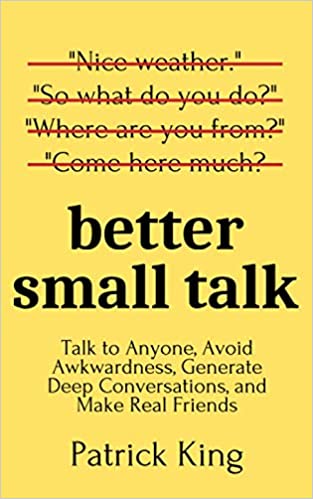Better Small Talk — Book Summary
Introduction
The author desires to enlighten and teach people on the importance of conversation. As a social interaction and conversation coach, he wrote this book based on his experiences over the years and studies that have been carried out in relation to; the impact of conversations, flawed stereotypes and prejudices that people carry within them which hinders quality conversations they would have had. Humans are social beings regardless of the person's personality and can only function well when there's good interaction with the environment.
Interesting quotes from the book
Think of it this way: conversation is a race, and you have to warm up and prepare yourself accordingly.
— Patrick King, Better Small Talk
Most people don’t barrel into conversation headfirst. Rather, they gently dip a toe in and test the waters.
— Patrick King, Better Small Talk
Summary of the book Better Small Talk
Chapter one is about small talk, the mindset of it etc. According to studies that have been carried out about this, contrary to what people think; humans are happier when they engage in conversations as little as exchanging pleasantries. There were reports of people who connected with a stranger noting a more positive experience compared to others in a group. We conclude that there could be awkwardness. However, there could be an unexpected connection that creates good connections. This was supported by another study that people think or assume they're better off keeping to themselves than having brief interactions. However, they are wrong as they are happier in this situation. There are ways to prepare to interact.
Chapter Two talks about making a good impression with small talk. This could be done by
- Deciding the right tone of words,
- Finding similarities with the individual,
- Making the first move, and
- Manufacturing a quality connection.
Small talk often happens without preparation, but it helps to have it at the back of your mind these qualities. The impression they pick out of a conversation determines what happens further on, their perception and interest of the person. It's best in keeping a good impression to make the first move and take charge of the conversation with a tone that suggests friendliness and connection.
Following these steps doesn't imply that it goes as desired because the other person also has to engage or open up. This might be handled by putting forth a topic or question that will get the person compelled to engage.
Chapter Three talks about how to keep up good energy and vibe that puts the person interested through the conversation and after. This is done by structuring a response with some elements of the story in it, leaving the person curious and wanting to find out more about the situation. This keeps the conversation interesting and going.
Here, the book explains that in keeping it captivating, it's best the story is one that is action filled. It could be one sentence short and might evoke an emotion from the listener (1:1:1 method).
Also, it is not just you talking but asking the person some kind of question. Questions that involve the person in the conversation and not just having a passive listener.
Chapter Four talks about keeping the conversation flowing and. This is actualized by avoiding shallow questions relating to the subject matter. There are a couple of directional helpful acronyms stated in the book which helps one keep the conversation flowing, set in motion, acronyms that can assist you in never running out of things to say on the fly. As mentioned, they are: HPM, SBR, and EDR.
HPM stands for History (your personal experience with the topic), Philosophy (your opinion on the topic), and Metaphor (what the topic makes you think of).
SBR stands for Specific (more detail on the topic), Broad (broader context of topic), and Related (related topics).
EDR stands for Emotion (the emotions the topic evokes in the other person), Detail (more detail on the topic), and Restatements (restating the topic to prompt greater elaboration).
Chapter Five focuses on how to get to the next level of closeness with the individual, such as giving compliments that go beyond surface level, complimenting the individual about their choices, values, and ideals. Ask better questions, keep it real and in depth.
Surface level questions will only bring about surface level responses. Because you're taking the lead in the conversation, make it largely about them, make the person feel comfortable and interested in, your response should be tailored directly to what was just said and not what you've already prepared in mind to say. Allow for both of you to wedge your thoughts into the conversation and avoid interrupting.
Chapter Six, which is the last chapter, talks about self-introspection by you as an individual, looking inwards, knowing yourself and finding the right values, truths and ideals. To do this, one has to learn more and read more, thinking more and exposing oneself to more. One has to be proactive in all situations, and be intellectually curious, developing opinions by thinking through different perspectives and becoming more knowledgeable in general and in every aspect.
Do not judge but try to instead take up the perspective that you lack adequate information to make a smart judgment, energize and make people curious, allow people find it easy to make small talk with you and make sure that your energy matches if not better.
A conversation is a series of statements, stories, and questions. After one person contributes one of those elements, the other person responds in kind, either on the same exact topic, or a topic that is in some way related to the original one. That's really it. Sometimes we'll have trouble thinking of what to say on the same topic, or finding a connection to another subject. But with all of the processes and steps learnt and mastered from this book, conversation becomes readily easy, and not just conversation as baseless but meaningful, impactful and rightly profitable in any particular aspect. Listening is a skill that should be learnt or actively taken cognizance of, it helps to make others feel good about the interaction, a conversation shouldn't be made just about you but you should rather also focus on the other person and actively explore the person.
Key Lessons from the Book
Lesson 1: Let Other's Talk.
Take sincere interest in other's stories. People enjoy talking about themselves, so make it easy for them to keep the discussion going by asking questions using the strategies in the book.
Lesson 2: Never stick to one line/format of questioning.
While chatting with people, consider the numerous types of questions you may ask. Let your range vary and keep them interesting too.
Lesson 3: Rephrase your questions so you'll have something to speak about.
You might rephrase the topic somewhat into something more fascinating in your life rather than attempting to be humorous. Instead of attempting to be humorous, come up with something intriguing or reflect the question back to your co-worker to see if they have anything fascinating to say.
Review of the book Better Small Talk
I found this book incredibly practical. It seems to go deep into a topic that doesn't even occur to the average Joe. Taking apart social interactions to find what makes it work is a huge selling point for this book.
Conclusion
We're all going to meet new people at some point in our lives. I believe that everyone can benefit from this substantial volume. You don't even have to be totally socially awkward to benefit from this. There is a science to small talk, and Patrick King definitely delivers in this book.
Don't miss the other book summaries on SunInMe.org

